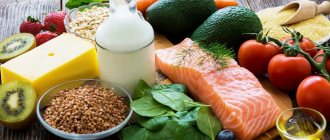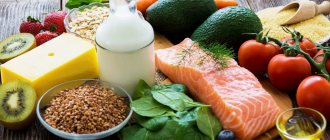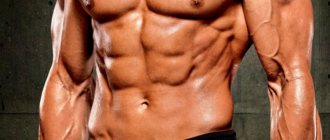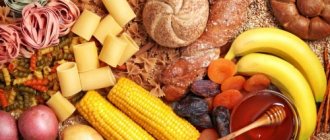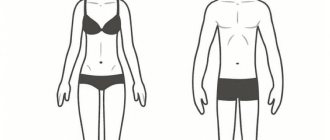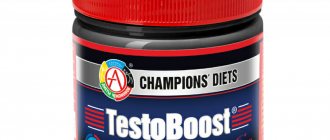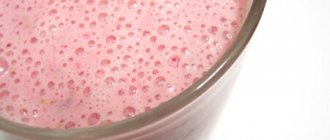A figure that is the envy of your friends, “seeing off” glances, a feeling of confidence and inner strength. Everything is achievable, just make a firm decision to change yourself. Give up bad habits, forget about weekends on the couch, train hard, no matter what. But most importantly, do not forget about the correct sports diet. It contains the key to a new active life.
Nutrition principles for gaining weight
An athletic figure implies beautiful, sculpted muscles. Simply losing weight is not the main goal in creating an attractive image. Therefore, in addition to focusing on burning fat, it is useful for girls to understand how muscle mass is built.
We do not recommend using diets. Yes, strict dietary restrictions will probably help you lose weight quickly. But you won’t be able to create a toned, athletic silhouette with a strict diet. In addition, you risk harming your health.
It is important to create a diet that will stimulate muscle growth, and not increase fat deposits. To do this, you must adhere to the fundamental principles:
- high calorie menu;
- the right combination of BZHU;
- fractional diet;
- calorie counting;
- taking sports supplements.
A few words about the myth widespread among women - “working with iron makes your figure masculine.” If you exercise without using steroid drugs, you don't need to worry about excessive muscle growth. The female body produces 7–10 times less testosterone than the male body. Therefore, you cannot spoil your figure even if you want to.
Caloric content of the diet
Nutrition to gain muscle mass should be high in calories. To find out how many calories you need to consume to gain muscle, first determine your basic daily requirement. To do this, use the following formulas.
Point 1 - initial calculation
Formula:
- Women from 18 to 30 years old: own weight in kg, multiply by 0.0621 and add 2.0357. Then multiply the resulting value by 240.
- Women from 31 to 60 years old: own weight in kg, multiply by 0.0342 and add 3.5377. Then multiply the resulting value by 240.
Point 2 - recalculation taking into account sports loads
Now you need to compare the number obtained in step 1 with the level of physical activity. If you don't play sports, leave everything as it is - you've found your basic daily requirement.
If you train 2-4 times a week, multiply the number obtained in step 1 by a factor of 1.3. If you do high-intensity exercise 4-5 times a week, multiply by 1.5.
Having determined the basic need, add another 200 kcal to it. The final number will be your individual daily requirement for gaining muscle mass.
Make a menu taking into account the obtained value and eat like this for a month. If your body weight stays the same or decreases by the end of 4 weeks, add another 100 kcal (from protein foods). Gradually increase your caloric intake until the weight goes up.
Calculation example
Task: calculate the calorie content of a mass-gaining menu for a girl (30 years old, weight 75 kg) who does strength training 3 times a week.
Solution:
- (75 x 0.0621 + 2.0357) x 240 = 1600 kcal;
- 1600 x 1.3 = 2080 kcal;
- 2080 + 200 = 2280 kcal.
Answer: daily caloric intake for muscle growth will be 2280 kcal.
The importance of a high-calorie diet is explained by physiology. If you reduce the calorie content of the menu (for example, in the hope of burning subcutaneous fat faster), the body will immediately respond to this by slowing down metabolic processes. The result will be a halt in progress in increasing muscle volume. Therefore, weight gain for girls must be accompanied by accurate calorie calculations.
Nutrition for gaining muscle mass for girls
No matter what loads and exercises women perform, it is all useless without proper nutrition. To gain weight for a girl, namely muscle, not fat, girls need to consume slow carbohydrates - 3-4 g per 1 kg of their own weight. This will ensure you have enough energy for your workouts to reduce the chance of muscle breakdown. In the afternoon, it is advisable for women to avoid simple carbohydrates:
- bakery;
- sweets;
- starchy vegetables;
- sweet fruits.
Because excess glucose will affect the storage of unwanted fat. Choose complex carbohydrates – grains and vegetables that are high in fiber.
Also read, list of foods for gaining muscle mass →
Like men, women need proteins , with an estimate of 2-3 g of pure protein per kilogram of weight. Animal protein is desirable - meat, fish, eggs, dairy products. Also, fat, namely fatty acids, is necessary for women's health and muscle growth. Fats are required in the amount of 1-2 g per 1 kg of weight.
The mechanism for building new muscle tissue in women is no different from the opposite sex. For muscle growth:
- you should not be hungry;
- it is important to eat 4-5 times a day;
- consume a lot of water.
Meals after workouts are especially important and should never be skipped .
All nutrients will repair injured muscle tissue, and this will lead to the appearance of new muscle fibers, so consume both protein and carbohydrates together within 40 minutes after exercise .
BZHU ratio during weight gain
We offer an example of calculating BJU for gaining muscle mass. But first, a little theory.
Firstly, 1 g protein = 4 kcal, 1 g fat = 9 kcal, 1 carbohydrate = 4 kcal.
Secondly, the BJU ratio for muscle growth is: 20%/30%/50%, respectively (the formula works for both men and women).
Let’s take an already familiar example: a 30-year-old girl, daily requirement is 2280 kcal. It is necessary to calculate the number of BZHU:
- Protein (20%): (2280 kcal x 20%)/100% = 456 kcal. Next, 456/4 = 114 g of protein per day (for example, 350 g of boiled chicken breast or 270–280 g of boiled pink salmon).
- Fat (30%): (2280 kcal x 30%)/100% = 684 kcal. Next 684/9 = 76 g of fat per day (for example, 80 g of olive or any other cold-pressed vegetable oil).
- Carbohydrates (50%): (2280 kcal x 50%)/100% = 1140 kcal. Next 1140/4 = 285 g of carbohydrates per day (for example, 1 kg of boiled buckwheat or 1 kg of boiled brown rice).
At first glance, it may seem that the volume of the diet is too large. But note that the products offered as examples are presented in already prepared form. Also, remember that all the food on your daily menu will be divided into 5-6 snacks. So don't be afraid. You will quickly get used to this amount of food and after a couple of weeks you will stop feeling any discomfort.
What should be the ratio of BZHU
The body requires the correct ratio of BJU to restore muscle tissue damaged by training and their subsequent growth.
- Proteins are the material for building muscles.
- Carbohydrates are a source of energy for construction.
- Fats play a role in the production of hormones and the transmission of nerve impulses.
Fats are also a good source of energy (their breakdown releases 2 times more energy than the breakdown of proteins and carbohydrates).
BJU ratio in grams:
- carbohydrates - 3-4 g per kg of body weight;
- proteins –1.6-2 g per kg of body weight;
- fats – 1.5-2 g per kg of body weight.
In mass, it is very important not how many calories you ate, but the ratio of BJU and its purity. It is important that the food is free of garbage, then the mass will be of high quality with a small amount of fat.
Squirrels
Based on their origin, proteins are divided into animal (meat, poultry, fish, eggs, dairy products) and plant (nuts, legumes). If we consider proteins according to their degree of digestibility, proteins can be divided into two categories: fast and slow.
The diet for gaining muscle mass should consist of 70-80% animal proteins.
Fast squirrels
They are almost instantly absorbed by the body. Complete breakdown requires only a few hours and a minimum of energy.
Main sources of fast proteins:
- chicken meat (ideally fillet) - contains 23 g of pure protein per 100 g of product;
- turkey meat - the amount of protein is similar to chicken fillet;
- lean beef and veal - 24 g of pure protein;
- fish and seafood - 17-21 g of protein depending on the type of fish;
- egg white - 15 g protein;
- milk and kefir - 3 g of fast, easily digestible protein;
- yogurt - about 5 g of protein.
Note. Protein from eggs and dairy products is absorbed by 100%, from meat and fish - by 90%.
Slow proteins
The duration of the breakdown of slow proteins is from 5 to 8 hours.
Main sources of slow proteins:
- cottage cheese - up to 18 g of pure protein (in the form of casein) depending on fat content and type;
- soybean - 36 g of protein per 100 g of product;
- beans - 23 g of slow protein;
- cereals and cereals - 8-13 g of protein;
- peanuts - 26 g protein;
- other nuts - 15-18 g.
Note. Cottage cheese is absorbed by the body 100%, vegetable protein is absorbed only 50%. In addition, it is also of poor quality (there is no complete composition of amino acids). That’s why every trainer will say that it’s almost impossible to build high-quality muscle mass as a vegetarian.
When to use slow and when fast proteins:
- If you have a hard day at work, then breakfast should consist of slow-cooking proteins.
- Before and after training, it is important to consume a sufficient amount of fast protein.
- If you have to skip one of your meals, then eat foods containing slow proteins.
- Dinner should consist of slow proteins of plant origin and fast proteins of animal origin.
- Before going to bed, it is better to eat a portion of low-fat cottage cheese (but not low-fat!) or take a portion of casein protein. Casein from cottage cheese is digested the slowest (up to 8 hours). It will nourish your muscles throughout the night and relieve hunger pangs. Which is very important for the masses.
Fats
Fats are divided into saturated and unsaturated. The latter are further divided into monounsaturated (Omega-9) and polyunsaturated (Omega-3 and Omega-6) fatty acids:
- saturated - butter, fatty cheeses, sour cream, eggs, fatty meat, palm and coconut oil;
- monounsaturated (Omega-9) - peanuts, olive oil, olives, avocados;
- polyunsaturated fats (Omega-6) - sunflower oil, corn oil, soybean oil, nuts, seeds;
- polyunsaturated fats (Omega-3) - fatty fish, fish oil, red and black caviar, oysters, flaxseed oil, flax seeds, chia seeds.
To ensure you get the right amount of saturated fat, consume dairy products with a certain percentage of fat content.
The amount of fat in the diet for building muscle mass is about 20-25% of daily calories, 10-15% should be saturated.
There are also so-called trans fats that should be avoided. Margarine, most confectionery products (sweets, cakes, pastries), semi-finished products, fast food are all trans fats.
Interesting. Fats are more easily absorbed by the body than proteins and carbohydrates. The body spends up to 30% of the total calories obtained from proteins on the breakdown of protein. It spends only 10% on fat breakdown. This explains the fact that body fat accumulates faster with a high fat diet than with a similar diet with more carbohydrates.
Carbohydrates
The last element of the supply trio. Carbohydrates are simple and complex (they are also called fast and slow).
Simple carbohydrates
They consist of molecules of simple sugars (sucrose, maltose, lactose). Let's go over each of them.
Sucrose
Consists of glucose and fructose. The main sources of sucrose: sugar, chocolate, ice cream, honey, jam, cakes, pastries and other sweets. All these products are likely to be stored as fat. You should not consume them even in small quantities. Just a spoonful of sugar added to tea and coffee can not only lead to excess weight, but also add wrinkles to your face.
Note. When sugar molecules (fructose or glucose) enter the body, they combine with proteins and fats to form the substance fructosamine. It leads to glycation - the main cause of aging of the skin and the entire body after 30 years. Fructosamine accumulates in cells and begins to destroy collagen and elastin fibers, which leads to the appearance of wrinkles.
This is why you still need to completely give up sugar. By the way, glycation is caused not only by sugar and sweets, but also by honey, dried fruits and many fruits, especially fruit juices. By chopping fruit into juice and smoothies, we completely deprive it of fiber, which slows down the absorption of fructose. Fructose itself is absorbed into the body several times faster and causes glycation.
Therefore, eat fruits in their pure form, in small quantities and pay attention to the GI (glycemic index). Eat fruits with a low GI, that is, those that have it no more than 40. These are unsweetened apples, pears, plums, apricots, citrus fruits, and berries.
Maltose
Consists of two glucose molecules. Maltose is found in beer, honey, and molasses.
Lactose
It is also called milk sugar. The main sources of lactose: milk, cottage cheese, kefir, yogurt (up to 5%). There is no lactose in fatty cheeses and butter with a fat content of 82.5%. And there is a lot of lactose in low-fat foods. This is why you need to consume dairy products with normal fat content. They contain saturated fats, which in moderate quantities accelerate fat burning, slow down aging, and reduce the risk of disease. It's not fat that's harmful, it's sugar!
Complex carbohydrates
They consist of starch and indigestible dietary fiber - fiber. It is complex carbohydrates that play a key role in nutrition for building muscle mass. When broken down, they release energy to the body gradually, providing a stable and long-lasting feeling of fullness. Carbohydrates, when consumed correctly, not only help build muscle mass, but also help prevent you from gaining excess fat.
Starch
Contained in grains, cereals, potatoes, legumes, durum wheat pasta, and some vegetables. In addition, there is such a thing as the biological value of products. For example, semolina and white polished rice have low biological value, i.e. they are low in minerals and B vitamins. In addition, they have a high GI.
Cellulose
Contained in vegetables and herbs. Although fiber is a carbohydrate, it does not provide the body with energy. It is involved in digestion and is necessary to maintain normal blood sugar levels.
The diet should consist of 50-60% “slow” carbohydrates, i.e. with low GI. In general, nutrition for building muscle mass for a girl should include at least 100 g of complex carbohydrates, of which 25-30 g will be dietary fiber.
The benefits and harms of a particular carbohydrate are determined by the glycemic index (an indicator of the rate of breakdown) and glycemic load (taking into account not only the source of carbohydrates, but also its quantity). You can find these indicators in tables on the Internet.
Best time to eat carbohydrates:
- For breakfast. In the first 3-4 hours after sleep, the body accumulates carbohydrates not in the form of fat, but replenishes the level of muscle glycogen.
- Before and after training. At this time, the body needs carbohydrates, and it doesn’t matter whether you are losing weight or building muscle mass.
- In general, it is best to consume most carbohydrates in the first half of the day. Anything that enters your body in the late afternoon is likely to be stored as fat. Late dinner should consist of a serving of protein and fiber in the form of a salad or steamed vegetables.
Products for weight gain
You can get the required daily caloric intake from cakes, soda and hamburgers. But in this case, the quality of the gained mass will be extremely low (subcutaneous fat, water). In addition, eating fast food and cakes will negatively affect your well-being. Therefore, a mass-gaining diet should consist of healthy foods:
- Proteins : red meat, chicken, eggs, fish, caviar, shellfish, rabbit, cottage cheese (preferably homemade), legumes, cheese, nuts.
- Fats : vegetable oils (olive, sesame, flaxseed, corn, pumpkin, sunflower).
- Carbohydrates : premium pasta, buckwheat, brown rice, pearl barley, oatmeal, whole grain bread.
In addition to foods for gaining muscle mass, you need to include fiber in your diet. This substance is not broken down by digestive enzymes, but is processed by the microflora of the large intestine. Fiber helps maintain normal functioning of the gastrointestinal tract and remove toxins from the body. The daily fiber intake is 20–40 g (for example, 350–400 g of vegetables). Fiber can also be purchased separately in powder form and added to dishes.
Very often on women's forums you can come across the term “foods with negative calorie content.” It is believed that the body spends more energy on digesting such foods than it receives from them.
In fact, there are no products with such “properties” (the exception is pure water). It would be more correct to say “foods with minimal calorie content” (non-starchy vegetables, herbs, some fruits and berries).
Vitamin and mineral supplements
In addition to high-calorie nutrition for weight gain, you should include vitamin-mineral complexes for girls. Such supplements are involved in many processes in the body, including the formation of new muscle fibers. Let's look at the benefits of individual vitamins and minerals:
- AT 12 . Supports the normal functioning of the nervous system, participates in the metabolism of proteins, fats, carbohydrates, stimulates the growth of muscle cells, and increases endurance.
- IN 1 . Participates in metabolic processes, helps synthesize hemoglobin, promotes the rapid transfer of oxygen through cells, and prevents the onset of overtraining.
- AT 2 . Promotes the oxidation of fatty compounds, participates in the conversion of energy into muscle contractions, helps transport oxygen, and makes muscles elastic.
- Vitamins A and E. Participate in protein synthesis, ensure the formation of glycogen in muscles, protect ligaments and tendons, and restore damaged fibers.
- Vitamin C . Acts as a powerful antioxidant, improves oxygen absorption, protects connective tissue, stimulates the production of hormones, and participates in the synthesis of protein and collagen.
- Minerals needed by athletes: potassium - helps to recover faster after strength training, phosphorus and calcium - ensure strong bones and normal functioning of the musculoskeletal system, magnesium - stimulates the synthesis of essential amino acids, zinc - participates in the formation of muscle cells.
For girls, special vitamin and mineral complexes are produced that take into account female physiology. The best are Opti-Women from Optimum Nutrition, as well as Ultra Womens Multivitamin Formula from VPLab Nutrition.
Fats
There are:
- saturated (eggs, milk, cheeses, meat);
- unsaturated (oils, avocados, seeds).
If there is too little fat in food, then the body’s metabolism slows down, and with a regular deficiency, the risk of developing diseases of the musculoskeletal system and circulatory disorders increases.
Fractional power mode
Mass-building nutrition and training must be properly correlated. Be sure to eat 2 hours before class (carbohydrates and some protein). This will give you energy to perform strength exercises and protect muscle fibers from breakdown. Immediately after exercise, take a gainer or protein shake. When you get home, have a full dinner (protein and fiber).
All products on the menu must be divided into 5-6 servings. Carbohydrates should be spread over the first 4 snacks. Proteins and fats should be included in every meal. In the evening, instead of carbohydrate side dishes, prepare vegetable salads.
Don't skip snack time. If you're out and about, eat a protein bar.
Example of a daily diet
We offer a daily menu for gaining muscle mass for a girl (30 years old, weight 75, daily requirement 2280 kcal) who does strength training.
Breakfast:
- Oatmeal with water - 200 g (180 kcal).
- White of 5 boiled eggs (75 kcal).
- Sandwich (grain bread, butter, cheese) - 60 g (150 kcal).
- Orange - 1 pc. (40 kcal).
Snack:
- Cottage cheese (fat content 5%) - 200 g (180 kcal).
- Nut mixture - 50 g (240 kcal).
Dinner:
- Boiled brown rice - 150 g (170 kcal).
- Boiled chicken breast - 150 g (170 kcal).
- Vegetable salad (tomato, cucumber, vegetable oil) - 70 g (50 kcal).
- Red apple - 1 pc. (50 kcal).
Afternoon snack:
- Protein wafers - 200 g (400 kcal).
- Kefir (fat content 3.2%) - 150 ml (80 kcal).
Dinner:
- Baked pink salmon - 250 g (300 kcal).
- Vegetable salad (tomato, cucumber, vegetable oil) - 150 g (100 kcal).
Snack before bed:
- Casein protein in water - 200 ml (120 kcal).
The total calorie content of the presented diet is 2305 kcal.
You can’t eat the same menu every day. Foods need to be changed, for example, instead of chicken, cook rabbit or beef, instead of vegetable salad, cut a green salad, etc. The more varied the diet, the more nutrients the muscles will receive for growth and recovery.
Strength training for skinny girls
Strength training is one of the main factors when it comes to gaining muscle mass. It is most effective to work out in the gym at least 3-4 times a week, paying attention to different muscle groups on each day.
Training at home will not give noticeable results, since exercise without weights does not provide muscle growth.
Example of exercises for 4 workouts per week:
Day 1 – legs.
Exercises: Leg press, barbell squats, dumbbell lunges, deadlifts, TRX single-leg squats.
Day 3 – chest and triceps.
Exercises: pull-down of a vertical block to the chest, lifting a barbell or dumbbells for the biceps, bench press of dumbbells or a barbell while sitting or on an inclined bench, rowing a barbell to the chin.
Day 5 – buttocks and legs.
Exercises: Lunges with a barbell on a Smith machine, lying leg curls, calf raises on a machine, leg abduction and abduction exercises, and also use leg abductions while standing in a pulley frame.
Day 7 – back and abs.
Exercises: on hyperextension, gravitron, abdominal bench, machine for vertical rows to the chest and behind the head with different types of grip.
Perform at least 3 sets of 12 repetitions.
Regular strength training will help thin girls gain weight.
The first sessions are best done with a trainer who will monitor the correctness of the exercises. FitCurves has a weight management program and professional support from experts.
And remember: not everyone is the same when it comes to losing weight or gaining muscle, so be patient and give yourself time to change. If you don't see any changes for a long time, you may be doing something wrong.
Sports nutrition
We have already talked about the benefits of vitamin-mineral complexes. Let's take a look at other useful supplements for muscle growth:
- Protein. Used to replenish protein in the diet. Whey, egg, and beef proteins are considered to be of the highest quality in terms of their amino acid profile.
- Creatine. The supplement helps increase energy reserves. Thanks to this, the athlete can train a little longer. The recommended form of creatine is powder monohydrate.
- Gainer. Helps thin people gain weight. In addition to protein, it contains a portion of “fast” carbohydrates, vitamins, and minerals. Suitable for girls with an asthenic body type.
- BCAAs. A complex of essential amino acids - leucine, valine, isoleucine. The BCAA complex helps prevent catabolism (muscle breakdown) and is involved in the synthesis of new fibers.
- A simple amino acid complex. Contains a set of nonessential and essential amino acids. Helps maintain muscle mass, suitable as a snack;
- Protein bar. Contains proteins, fats, carbohydrates. Mainly used for a light snack when the athlete cannot eat a full meal.
Sports nutrition is not a steroid drug. You shouldn't expect rapid muscle growth from taking protein or creatine. These supplements help compensate for the deficiency of any elements and provide additional energy for strength exercises. Before use, we recommend consulting with an experienced fitness trainer.
